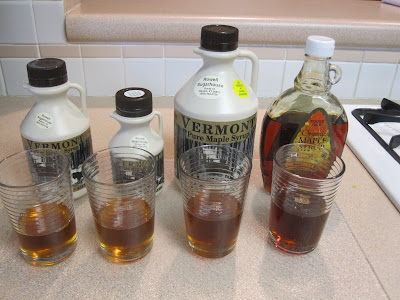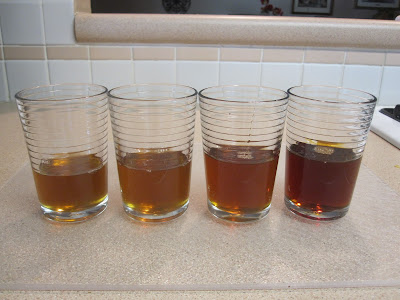While in Vermont and New Hampshire recently, we were exposed to maple syrup and learned that there are different grades. In Walden, Vermont, we stopped at Rowell Sugarhouse and purchased three different grades with the intent of taste-testing them to see if we could discern a difference, and if so, which one we liked the most. We bought: (a) Fancy, which we also saw as Grade A Light Amber; (b) Grade A Medium Amber; and (c) Grade A Dark Amber. We also saw Grade B Dark Amber which we did not buy.
I did a little research on maple syrup and was surprised to find that 75% of the world's production comes from the province of Quebec, Canada and another 5% comes from other provinces in Canada. I suspect that is a great part of the reason that the sugar maple leaf is found on the Canadian flag.
Vermont produces 5.5% of the world's maple syrup supply, and Vermont has the sugar maple as the state tree and sap collection depicted on its state quarter.
Other U.S. states that produce marketable quantities of maple syrup include New York (which produces about one-half of what Vermont does), Maine (which produces about one-third of what Vermont does), and Wisconsin, Ohio, New Hampshire, Michigan, Pennsylvania, Massachusetts and Connecticut, which each produce less than one-tenth of what Vermont does.
Grading in the U.S. is based on translucence (how much light is allowed to pass through it): Grade A Light Amber has to be at least 75% translucent; Grade A Medium Amber has to be 60.5 to 74.9% translucent; Grade A Dark Amber has to be 44 to 60.4% translucent; and Grade B Dark Amber has to be 43.9% or less translucent. The light syrup is more mild and it develops a greater maple flavor as it gets darker. Our syrup is below in order of light to dark.
Most maple syrup comes from the sugar maple, red maple and black maple because of the high sugar content in the sap, between 2% and 5%. A tree is not usually tapped until it is at least 30 years old and a tree can support one to three taps, depending on the trunk diameter. An average tree will produce up to 3 gallons of sap in a day and 9 to 13 gallons of sap per season. The season will last four to eight weeks, depending on the weather. The sap is then boiled down to obtain the syrup. Depending on the concentration of the sap, it will take 5 to 13 gallons of sap to produce a quarter gallon of syrup. The syrup is filtered to remove sugar sand which has a gritty texture and it is graded while it is still hot. The Cornell Sugar Maple Research & Extension Program states that syrup grade is impacted by weather conditions, time during the season when the sap is collected and the processing technique. Other internet sites indicate that the grades correspond to the time within the season when the sap is collected. The lighter grades are produced early in the season (when there is more sugar in the sap) and the darker grades are produced later in the season (when there is less sugar in the sap).
We saw packages which contained small containers, one for each of the four grades. The color difference was quite noticeable. The three we purchased are less discernible color wise,
but there is a definite difference taste-wise. We did both a dip the finger in the syrup taste test and tried each type on a pancake. I found the Light Amber to be sweet without a deep taste. Judy said it was too mild, not mapley enough.
I found the Medium Amber to have a more full taste, to have more substance. Judy felt it was not as sweet, but had more flavor.
I found the Dark Amber to be thicker, more full and more mapley. Judy felt it was stronger and more mapley.
We both highly preferred the Dark Amber and I am kicking myself for not also buying some Grade B Dark Amber as I suspect I would like it even more. I had only eaten pure maple syrup a few times in my life. The syrup I had growing up was a boiled mixture of sugar, water and maple extract. It may be that it had a stronger flavor. The woman I talked to at Rowell Sugarhouse said the maple syrup producers prefer the Light Amber and keep it for themselves.
A few days later, Judy came home from Trader Joe's with some Grade B Dark Amber. So we just had to go through our taste test again, this time with four different grades of maple syrup. From left to right, Grade A Light Amber, Medium Amber, Dark Amber and Grade B Dark Amber.
A few days later, Judy came home from Trader Joe's with some Grade B Dark Amber. So we just had to go through our taste test again, this time with four different grades of maple syrup. From left to right, Grade A Light Amber, Medium Amber, Dark Amber and Grade B Dark Amber.
Just as we suspected, the Grade B Dark was less sweet and more mapley.
and
To me, it almost had a coffee flavor. Judy, who does not like coffee flavor, disagreed and really liked it. I made up a batch of pancakes and tried each grade on a pancake. The picture below is of a pancake with Grade B Dark Amber.
Judy preferred the more mapley Grade B on her pancakes. I preferred the less mapley Grade A Dark Amber. In fact, this time I decided I liked the lighter, sweeter, Grade A Light Amber. It has been really fun to take a product we know little about and get to know it better.












I remember reading a scholarly article from an LDS scholar that hypothesized that the Smith Family was in the middle of Sugaring when Joseph went into the grove for that prayer that became the first vision. I don't remember what evidences were offered. However, that's what I think of now when I see the pure maple syrup.
ReplyDeleteHow fun, I've never heard that. I may need to search for the source.
ReplyDelete